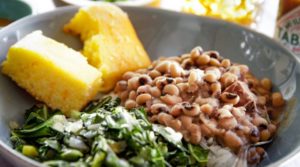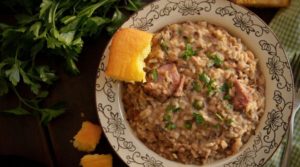
After living through 2020, the New Year can’t come soon enough. When 2021 arrives, I pray it comes with good luck. To ensure good luck comes my way, I will not tempt fate. On New Year’s Day I will not eat chicken. I’ll eat pork.
Chickens scratch backward, representing looking backward and risking reliving the old year. Pigs root forward, symbolizing moving forward where opportunities are found. In short, eating pork brings good luck.
I’m not the only one who will be eating for good luck on New Year’s Day. People have been doing it for centuries. But here’s the catch: You have to eat the right things. Some cultures will encourage one to eat oysters, while others claim serving a whole fish (signifying a good beginning and end) will bring good luck. Southerners eat blackeyed peas with a side of golden cornbread to bring good luck. Germans wouldn’t dream of venturing into the New Year without eating a bite of pickled herring. And in parts of Spain, 12 grapes are gobbled when the clock begins to strike midnight, bringing good fortune to those who can down all 12 grapes before the clock stops chiming.
Wishing for prosperity? Eat foods that resemble money – coins and folding money, such as peas, beans, lentils, lettuce or cabbage. Long noodles and rice are served in China, representing longevity and abundance. And don’t forget to butter your bread. Irish tradition claims placing a slice of buttered bread outside the front door ensures no one inside will go hungry.
Chocolate also makes it to the top-10 list of lucky foods because of the richness and sweetness it offers to life. A gift of chocolate is considered an ultimate harbinger of good fortune when received from a true friend. Likewise, nutmeats are food gifts of luck. Harvested toward year’s end, nuts represents an ending and a new beginning.
Hoppin’ John, the traditional Southern African-American blackeyed peas recipe is America’s most popular New Year’s food. Hoppin’ John’s key ingredients of blackeyed peas, also known as cow peas, and rice is associated with wealth, but it’s the recipe’s folklore that presents an interesting tale as to why it’s served on New Years Eve. As the story goes, cowpeas (blackeyed peas) and rice were one of the few things left to eat during a New Year’s Eve siege of a Southern city during the Civil War. Because of that bowl of Hoppin’ John the city did not starve.
Perhaps good luck foods are best explained in a single word: survival. This signifies the hope of having enough of what one needs to survive with a few extras goodies throughout the year – the essence of luck and prosperity, which is always best displayed on the dinner table.
To help bring a little luck to the New Year, give one of the following Hoppin’ John recipes a try, courtesy of Camellia Beans.

Old-Fashioned Slow Cooker Blackeyed Peas
1 (1-pound) package blackeyed peas (Camellia Brand, if available)
1 onion, diced
3 cloves garlic, minced
1 ham hock or a 1/2-pound diced ham
6 cups water or chicken broth
Salt, pepper and hot sauce, to taste
Rinse and sort peas. Add peas, onion, garlic, ham hock or diced ham, and water or broth to slow cooker. Stir well and cover. Cook on low for five to six hours or until peas are desired tenderness. Season to taste.

Instant Pot New Orleans-Style Blackeyed Peas
Servings: 8
1 (1-pound) package Camellia brand black-eyed peas
2 tablespoons vegetable oil
1 pound pickled pork (or smoked ham) cubed to 1/2-inch
1 large onion, chopped
1 large green bell pepper, chopped
3 stalks celery, chopped
4 cloves garlic, chopped
1 tablespoon tomato paste
5 cups lightly salted water or chicken broth
2 bay leaves
Salt, pepper, hot sauce, to taste
Hot cooked rice
Cornbread
1 bunch green onions, sliced
Rinse and sort peas. Press the sauté button on the Instant Pot, and add the oil. Add pickled pork and sauté five minutes or until browned. Remove pickled pork to a paper-towel lined plate and reserve. Add onions, bell pepper, celery, garlic and tomato paste to Instant Pot, and sauté until vegetables are soft. Add pickled pork back to the pot, along with blackeyed peas, water or broth, and bay leaves. Stir well. Turn sauté mode off. Cover Instant Pot, twist to lock the lid, and turn the valve to sealing. Press the beans/chili button, or use the manual mode and set to 30 minutes.
When the timer beeps, allow the pressure to release naturally for 20 minutes. Then, turn the valve to venting. Remove lid. If a creamier texture is desired, use the back of a spoon or potato masher to mash peas to desired consistency. Adjust seasonings to taste. Serve over hot cooked rice with cornbread or hot buttered French bread. Garnish with chopped green onions.
Tips: If after cooking, peas are soft but there’s too much liquid remaining, use sauté mode and cook until thickened. If peas are not soft enough after cooking, put the lid back on and make sure the release valve is set to sealing. Use manual mode to cook at high pressure for another five to 10 minutes. The pot will quickly come back up to pressure because the contents are already hot.
